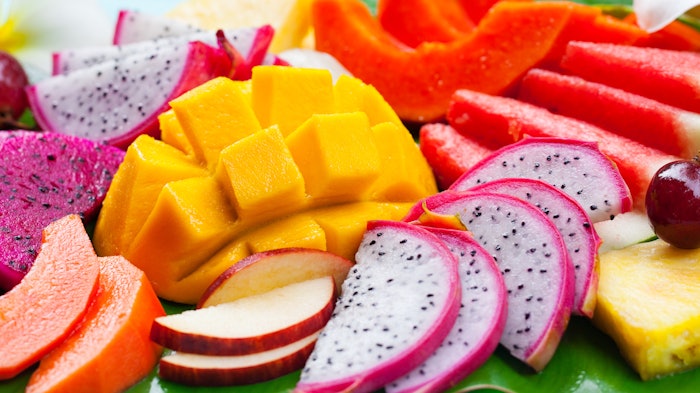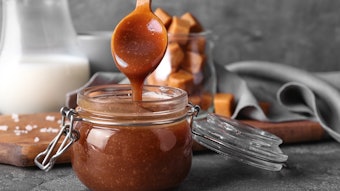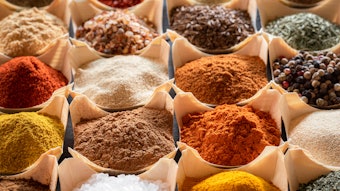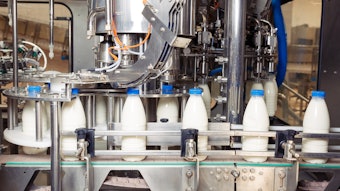
cis-3-Hexenol is often used in combination with one or more cis-3-hexenyl esters. cis-3-Hexenyl hexanoate (FEMA #3403, CAS #3150-11-8) is an interesting option in two respects. Most importantly, it has a distinct tropical tinge that fits perfectly in that unusually wide category of fruit flavors. Secondly, it is much less volatile than all the obvious alternatives, such as cis-3-hexenyl iso-valerate, but still packs a punch in practical flavors. This advantage of excellent heat stability broadens its usefulness way outside the tropical fruit category.
This article is only available to registered users.
Log In to View the Full Article
cis-3-Hexenol is often used in combination with one or more cis-3-hexenyl esters. cis-3-Hexenyl hexanoate (FEMA #3403, CAS #3150-11-8) is an interesting option in two respects. Most importantly, it has a distinct tropical tinge that fits perfectly in that unusually wide category of fruit flavors. Secondly, it is much less volatile than all the obvious alternatives, such as cis-3-hexenyl iso-valerate, but still packs a punch in practical flavors. This advantage of excellent heat stability broadens its usefulness way outside the tropical fruit category.
Note that the dose rates given throughout this article are the levels suggested for use in flavors intended to be dosed at 0.05% in ready-to-drink beverages or in a simple bouillon.
Tropical Fruit Flavors
Acerola: Thirty ppm of cis-3-hexenyl hexanoate brightens acerola flavors noticeably.
Banana: This raw material is particularly effective in banana flavors, and the suggested use level partially reflects that. Two hundred ppm is a reasonably moderate starting point.
Cherimoya: Flavors gain freshness from a moderate addition of cis-3-hexenyl hexanoate, around 100 ppm.
Dragonfruit: A similar level, 100 ppm, has a similar effect in dragonfruit flavors.
Durian: Durian is dominated by heavy sulfur notes, but 50 ppm of cis-3-hexenyl Durian is dominated by heavy sulfur notes, but 50 ppm of cis-3-hexenyl hexanoate has a subtle brightening effect.ME Image at Adobe Stock
Durian is dominated by heavy sulfur notes, but 50 ppm of cis-3-hexenyl hexanoate has a subtle brightening effect.ME Image at Adobe Stock
Guava: cis-3-Hexenyl hexanoate counterbalances the heavy cinnamates in guava flavors. Levels are very variable, but 100 ppm works well.
Jackfruit: The best level of addition of cis-3-hexenyl hexanoate in jackfruit flavors is around 200 ppm.
Kiwi: The same 200 ppm-level is perfect in kiwi flavors. Kiwi is quite a subtle flavor within the tropical category and this level adds noticeable, heat stable, freshness.
Mango: Levels are much higher in mango flavors, perhaps a little surprising given the sensory distance between mango flavors and passionfruit flavors. Eight hundred ppm is not overdone.
Mangosteen: Mangosteen flavors bring us back into the modest category. Fifty ppm is useful, but not intrusive.
Passionfruit: The link between cis-3-hexenyl hexanoate and passionfruit flavors is so obvious, adding to freshness and also the central tropical note. Levels can be quite high, starting at 1,000 ppm.
Pineapple: The best level of cis-3-hexenyl hexanoate in pineapple flavors depends very much on the effect required. Two hundred ppm adds attractive freshness. Levels up to 1,000 ppm can also work, giving enhanced fruit and obvious freshness.
Sapodilla: Sapodilla flavors are an interesting, but minor, category. cis-3-Hexenyl hexanoate is only needed at around 30 ppm to brighten the profile.
Soursop: Similar comments could be made about soursop flavors. The ideal level is only a little higher, around 50 ppm.
Berry Flavors
Blackberry: Most berry flavors, with one very obvious exception, normally tread a fine line between ideal ripeness and freshness. In consequence, the ideal level of cis-3-hexenyl hexanoate is often modest. For blackberry flavors, 100 ppm works well.
Blackcurrant: A slightly higher level, around 200 ppm, is more effective in blackcurrant flavors because of the dominant sulfur notes.
Cranberry: Despite the eventual stewed fate of many cranberries, the flavor benefits from a hint of freshness. One hundred ppm of cis-3-hexenyl hexanoate provides that.
 Loganberry flavors often have some characteristics in common with blackberry flavors.Solivox at Adobe Stock
Loganberry flavors often have some characteristics in common with blackberry flavors.Solivox at Adobe Stock
Raspberry: A similar addition can be one way of optimizing raspberry flavors. Another, possibly better, option is to split the fruity green note between cis-3-hexenyl hexanoate and cis-3-hexenyl formate. This mixture adds a hint of rawness.
Strawberry, Fresh: This flavor is the obvious exception within the berry category. Very obvious green notes work well in combination with ripe notes. cis-3-Hexenyl hexanoate is a very good companion to cis-3-hexenol at a wide range of levels, starting at 500 ppm.
Other Fruit Flavors
Melon, Canteloupe: cis-3-Hexenyl hexanoate can be used in watermelon flavors, but it is far from essential. Cantaloupe melon flavor, in contrast, benefits considerably from around 50 ppm.
Peach and Apricot: This raw material highlights the separation between peach and apricot flavors. Five hundred ppm of cis-3-hexenyl hexanoate is ideal for peach flavors, but is a whole order of magnitude too high for apricot flavors.
Plum: Plum, and to a lesser extent damson, flavors benefit from the added freshness of cis-3-hexenyl hexanoate at 200 ppm.
Pomelo: cis-3-Hexenyl hexanoate is not a raw material that springs to mind for citrus flavors, but it does enhance pomelo flavors. Levels vary depending on the emphasis on peel or juice notes, but 100 ppm is a good place to start.
Rhubarb: Methyl phenyl carbinyl acetate has a hint of green in its profile, which is fleshed out nicely by 100 ppm of cis-3-hexenyl hexanoate.
Other Flavors
 cis-3-Hexenyl hexanoate is very effective at levels of addition in the region of 200 ppm for honey applications.slawek_zelasko at Adobe stock
cis-3-Hexenyl hexanoate is very effective at levels of addition in the region of 200 ppm for honey applications.slawek_zelasko at Adobe stock
Pepper: All pepper flavors need to offset the pungent methoxy pyrazine notes. cis-3-Hexenyl hexanoate is great because it softens the green notes, adds useful freshness and also adds a hint of fruit in Jalapeno flavors. One hundred ppm is a good starting point.
Tea: Despite the obvious differences, there are a number of common ingredients that are important in all tea flavors. Levels of cis-3-hexenyl hexanoate range from 40 ppm in black tea flavors up to 200 ppm and more in green tea flavors.
Tomato, Fresh: cis-3-Hexenyl hexanoate adds freshness and depth to tomato flavors, blending well with the other green notes. Levels ranging from 50 ppm and up work well.










